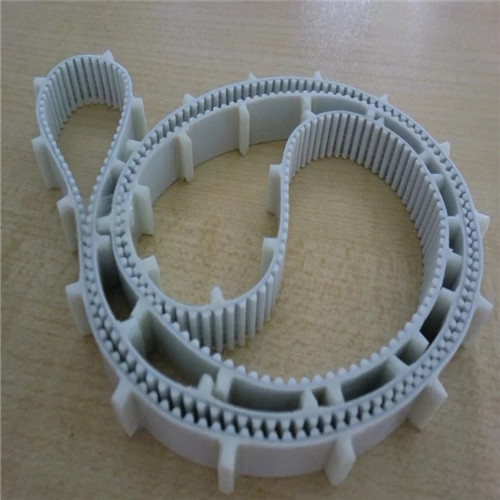When designing a synchronous belt with integral blocks (also known as timing pulley belts with attached lugs or teeth), several critical considerations should be taken into account to ensure optimal performance, reliability, and longevity. Here’s an overview of the key aspects to focus on:
1. **Block Geometry and Attachment**:
– The design of the blocks or lugs must match precisely with the corresponding grooves on the pulleys to ensure positive engagement and prevent slippage.
– The attachment method of the blocks to the belt body should be robust enough to withstand significant shear forces and torsional stress during operation without detaching. This might involve specialized bonding techniques or integrally molded structures.
2. **Material Selection**:
– Both the base belt material (such as polyurethane for PU belts) and any adhesives or bonding materials used for attaching the blocks should have compatible mechanical properties and resist degradation due to frictional heat, chemicals, or environmental factors.
– The block material should also have adequate hardness and wear resistance to minimize wear against the mating pulley.
3. **Load Distribution and Stress Analysis**:
– Careful analysis of load distribution across the belt and blocks is necessary to avoid overloading certain sections, which can lead to premature failure or distortion of the belt.
– Ensure proper stress relief designs so that the belt does not distort under dynamic loads, especially during acceleration and deceleration phases.
4. **Accuracy and Tolerances**:
– High manufacturing tolerances are essential for maintaining accurate alignment of the blocks along the belt length and height, ensuring uniform engagement with the pulleys.
– Precision in the tooth profile ensures smooth running, minimizes vibration, and prolongs bearing life.
5. **Belt Flexibility and Fatigue Resistance**:
– Design the belt to allow for sufficient flexibility around small diameter pulleys and accommodate for any deflection under load without compromising the integrity of the block attachments.
– Consider fatigue resistance properties, particularly in applications involving cyclical loading or reversing direction frequently.
6. **Operating Conditions**:
– Account for operating temperature ranges, as extreme temperatures can affect the physical properties of both the belt and adhesive materials.
– If applicable, ensure the belt meets any specific requirements for corrosion resistance, UV protection, or resistance to oils and chemicals present in the working environment.
7. **Lubrication and Maintenance**:
– Although many synchronous belts operate without lubrication, if lubrication is required, choose materials and designs that can manage lubricant presence effectively and prevent its interference with the block-to-pulley interface.
8. **System Dynamics**:
– Assess the dynamic behavior of the entire system to ensure that vibrations and resonance frequencies do not coincide with the operating frequency, which could cause premature failure or decreased efficiency.
9. **Service Life Estimation**:
– Based on expected loads, speeds, and environmental conditions, estimate the service life of the belt to determine appropriate replacement intervals or warning signs for wear.
By addressing these issues in the design phase, engineers can create a synchronous belt with integral blocks that performs reliably and efficiently within its intended application, reducing maintenance costs and improving overall system performance.